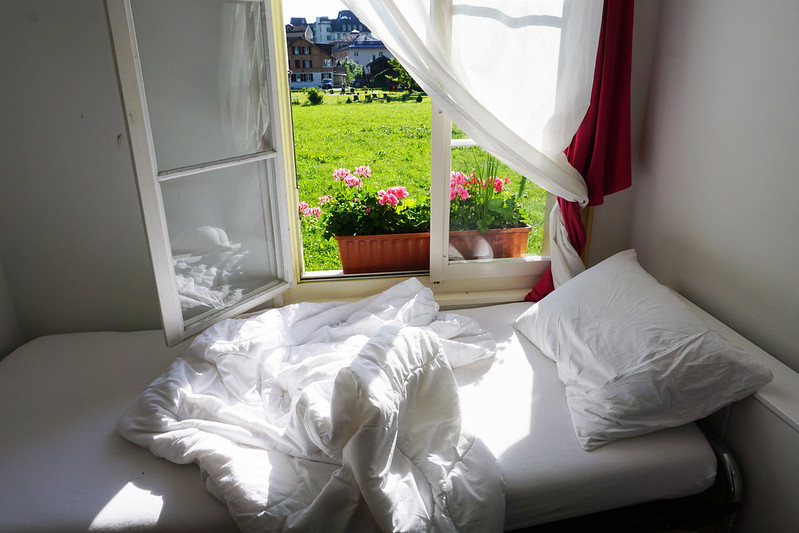Comparing Costs of Rail Travel in Europe
James Martin is a travel writer and photographer who writes, photographs, and edits stories about western Europe.
:max_bytes(150000):strip_icc()/italy-fast-train-56a3a41f3df78cf7727e6565.jpg)
One of the most frequently asked questions about European Rail Travel is “How much does it cost?” followed by “Should I buy a pass?” We kept track of our expenses on our summer of 2003 trip just to give you an idea of the cost of a trip done entirely by walking up to a ticket window and buying the day’s train ticket. We’ll compare it to what it might cost had we rented or leased a car for the same trip, and we’ll tell you how a railpass would have worked had we bought one.
Europe by Rail
Two of us traveled in a round trip from Zurich through Italy, Austria, the Czech Republic, Germany, and back to Zurich. We bought tickets by walking up to the ticket counter at rail stations and purchasing them.
Each country maintains its own pricing structure. In general, Italy is relatively cheap for train travel, as is the Czech Republic. Germany and Switzerland are fairly expensive, so the total trip is pretty representative of what you’ll find in Europe.
The table below outlines our trip. Costs have been translated into US dollars and rounded, even though all tickets were purchased in local currency.
Rail Travel – Leg of Journey Cost for 2
Zurich – Bellinzona Switzerland 70
Bellinzona to Padua, Italy 71
Padua to Venice, Italy 6
Venice to Villach, Austria 73
Villach to Vienna, Austria 58
Vienna to Brno, Czech Republic 41
Brno to Prague 30
Prague to Leipzig, Germany 70
Leipzig to Nuremberg, Germany 108
Nuremberg to Munich 21
Munich to St. Gallen, Switzerland 90
St. Gallen, Switzerland to Zurich Airport 35
TOTAL for 2 people– $673
Note: Be aware that you can’t order tickets for local trains off the internet as far as we know. The prices you’ll see listed on the Internet for Padua to Venice, for example, will cost considerably more than we paid because they’re for the most expensive express train running on that line–another reason to do like the locals and just buy your tickets when you need them. For overnight trips and on international trains that require seat reservations, you will want to buy your ticket a day in advance if possible.
Leasing a Car
The cheapest rate for leasing a car (a small Peugeot) for 30 days listed by Auto Europe at the time of writing was $719–and you still have to pay for gas. Of course, if there’s more than two of you this might turn out to be the budget option. You can see more in a car and can motor around the countryside, visiting smaller towns and country villages. But if you just want to see the major cities it’s easier to forgo the car and related parking headaches and just hit the train stations. We try to vary our trips by the size of towns we want to visit–last year it was the major centers and we went by train, next year we’ll take in smaller towns and villages and lease a car.
Eurail Pass
Rail passes can be a bargain. Back in the 70s, they were always a good deal. Today you have to plan your trip well to make use of the many types of European Rail passes available.
You’ll find that on a trip like ours above, the prices for a rail pass for each person would exceed our example. That’s because we’ve traveled relatively short distances each trip, visited countries where rail travel is relatively cheap, and used second class tickets rather than first class.
We hope this information is of use to you when choosing a method of traveling through Europe. Have fun traveling!
How Much Does A Trip to Europe Cost
When you hear the word Europe, you will probably imagine the Eiffel Tower in Paris, Stonehenge in England, the Colosseum in Rome, the Acropolis of Athens, and the Neuschwanstein Castle in Germany, to name a few. In a nutshell, there are so many places to visit and things to experience in Europe. On this note, how much does a trip to Europe cost these days?
Cost of a European Trip
Apparently, it is very challenging to give a ballpark estimate for any travel expenses since there are a lot of things to consider. Europe trip cost is no different. You have to factor in the number of days you will be staying , the cost of airfare, the choice of accommodation, and your itinerary, to name a few.

However, $5,000 for five to seven European countries for a month would be a decent estimate for a solo traveler. This could even be way too much if you spend more time in the eastern part of Europe.
Cost Breakdown
Since the cost of a European trip varies based on different factors, let us assume that you are traveling alone . With that said , here is the cost breakdown for the trip, with an emphasis on individual costs so you can adjust your budget based on how much you want to splurge .
T he cost will depend on where you are flying from , your country and city of destination, and which airline and seat class you choose. A round trip ticket from the US to London, like Heathrow-JFK round trip economy class by British Airways for the month of June, sells for around $650 . However, it costs way more at Delta Airlines for the same flight details at more than $2,100.
If you want to get the cheapest rates, fly around in the winter months when airfare prices can be as low as $200 to $400.
The cost of accommodation depends on where you want to stay. You can choose among dorm beds, hostels , or hotel s .
The expenses may range from $10 to under $100 per day , with hostels being the most affordable at $10 to $15, obviously . On the other hand, cheap hotels in France, for example, can range from € 22 to €75, or around $27 to $91 per day.
R estaurants in Europe can be a bit expensive . However, there are cheaper options like food stores, fast-food restaurants, or cafés that offer affordable meals , as well as, bars if you want to drink.
For this part, you can spend at least $30 –$55 per day if you are willing to not overindulge .
- Day trips and attractions
These include entrance fees to museums and other must-go tourist destinations. Most of the museums are free, but those with entrance fees range from $10 to $20.
I n the Netherlands, the Van Gogh Museum has an entrance fee of €10, or around $12.19 for students, and €19, or around $23.17 for adults. On the other hand, Anne Frank House charges €14 for adults, or around $17.07, €7.00 for 10 to 17-year-olds, or around $8.53, and €1 for 0 to 9-year-olds, or around $1.22 .
One important aspect of traveling overseas that people might overlook when calculating how much it costs to go to Europe is transportation. When roaming around, you will need to spend on bike rentals, taxi s , bus, and train fares. However, the prices vary from place to place.
If you are planning to do some train-hopping in Europe, purchasing a Eurail pass would be more convenient and cost-efficient. It is a single train pass that allows you unlimited travel to any participating train network within Europe within a certain number of days or months.
The cost of a Eurail Global Pass ranges from $226, which can be used for four days within one month, to $826, which can be used for three months straight.
The price of drinks in Europe can be costly. It is not even uncommon to find beers costing more than €5 each or more than $6.
However, organized bar tours are everywhere and can offer very affordable prices, usually between $10 and $15 . I f you add unlimited drinks , then , you can add around $10 to $15 more .
Basically, every big city in Europe offers pub crawls ; the one s in Budapest being highly recommended . O ne reason for that is the abundance of ruin bars, which are some of the capital’s unique feature s .
- Shopping for gifts and souvenirs
Answering the question of h ow much does it cost to go to Europe wouldn’t be complete without some shopping on the side. Europe has so much stuff to offer tourists, such as postcards, magnets, keychains, t-shirts, figurines, snacks, and chocolates, to name a few.
So, if you enjoy buying gifts and souvenirs, then , it is ideal to bring enough for this kind of memento . You can at least have a budget of $230 and you are good to go .
Europe’s World Wonders and Centuries-Old Universities
W hen it comes to attractions that you need to see in real life, the European continent takes pride in its fascinating natural world wonders, which have been mysteriously built or shaped for so many centuries.
It houses extraordinary skyscrapers and other man-made structures dating back to classical times. It has palaces, castles, towers, bridges, sacred buildings, and even centuries-old institutions that have become famous all over the world.
A few of its w orld wonders, which you will surely be tempted to visit, are the following:
- The Athenian Acropolis, Delphi, Mount Athos, and Santorini in Greece
- Aletsch Glacier in Switzerland
- The Alhambra and La Sagrada Familia in Spain
- The Atomium in Belgium
- The Eiffel Tower, Louvre, and Versailles Palace in France
- The Giant’s Causeway in Northern Ireland
- Hieronymites Monastery in Portugal
- Cologne Cathedral in Germany
- The Colosseum, St. Peter’s Basilica, and Leaning Tower of Pisa in Italy
- The Oresund Bridge, which connects Denmark and Sweden
- Stonehenge in Great Britain
- Buckingham Palace and London Eye in England
- Sistine Chapel in Vatican City
You can also visit some of the oldest universities in the world that are in Europe. These include:
- University of Bologna in Italy: year 1088
- University of Vienna in Austria: year 1365
- Uppsala University in Sweden: year 1477
- University of Copenhagen in Denmark: year 1479
- University of Valencia in Spain: year 1499
Do You Need Visa To Go To Europe?
US citizens do not need to obtain a visa to travel to European countries that are members of the Schengen Area. As such, you are allowed to stay for up to 90 days in any of the 22 member countries comprised of:
- Austria
- Belgium
- Czech Republic
- Denmark, Estonia
- Finland
- France
- Germany
- Greece
- Hungary
- Iceland
- Italy
- Latvia
- Liechtenstein
- Lithuania
- Luxembourg
- Malta
- Netherlands
- Norway
- Poland
- Portugal
- Slovakia
- Slovenia
- Spain
- Sweden
- Switzerland
However, there are some exceptions to this, as not all US citizens and US residents are allowed to enter Europe visa-free due to a couple of circumstances. Here are a few of those who need to get a Schengen visa:
The cost of traveling Europe: real budget numbers from 9+ years of travel

As someone who has been traveling full time for nearly nine years, most of that time in Europe, these are probably the questions I get most often about my lifestyle.
Money, unsurprisingly, is the biggest obstacle people think they’ll face on the road. Because if vacations are so pricey, wouldn’t full-time travel be even more so?
This is why for the last 9+ years, while I’ve been traveling full-time, I’ve kept track of my budgets all over the world. Because the truth is that full-time travel can be expensive (just like staying put can be expensive), but it doesn’t have to be. And the only way I know to prove it is to share my own real budgets.
Today, I’m back to share more budget updates with you. More insights into how I travel full-time and what it costs to live and travel in Europe.
First, though, let’s talk about travel styles…

Luna sporting bedhead in Gozo, Malta.
What full-time travel looks like for me
First, it’s important to say that there’s no right or wrong way to travel full time. There’s no standard. Every person I know who does it does it differently.
I have friends who circle back to their favorite places every single year. I have friends who are always chasing new adventures. I’ve met digital nomads who live out of hostels and move every few days and nomads who spend a year or more in one place.
So, before I dive into how I travel, I’ll caveat it by saying that my way is not the way. There are people who travel on a much lower budget than mine and people who travel on a higher budget than mine. There are people who travel faster and people who travel slower. This budget breakdown is based on my experiences and my experiences alone.
Okay, so what are my experiences?

A moody Gozo landscape.
For the first few years, I traveled solo with my dog. For five years, I traveled as part of a couple (though my budgets here on the blog reflect my half of shared expenses + 100% of my personal expenses). And now I’m back to solo-girl-with-dog-takes-on-the-world.
I mostly travel around Europe, though I’ve also done a bit of North and South America in the past few years (and before I hit the road full-time, I visited every continent except Antarctica).
I prefer to stay in one place for at least a month (and sometimes two or three) and I tend to rent comfortable apartments in local neighborhoods. If I’m staying in a hotel or hostel, it’s usually only for a weekend trip or a travel day.
I’m a foodie through and through, so I devote a large portion of my budget to good, fresh, usually organic food and I eat out pretty regularly, especially if I’m in a place known for its cuisine.
I work part-time (on content strategy and copywriting). This means big chunks of my week are devoted to work, so someone retired or vacationing is likely to spend quite a bit more than I do.
And in my spare time, I love to cycle, hike, read, explore, and eat, most of which is cheap or free and keeps entertainment budgets on the low side. I rarely do museums or indoor attractions.

Sheep fleeing the scene on a long hike in the Swiss Alps.
The cost of traveling Europe: monthly expense breakdown
Before we get into individual budgets around the world, here’s a breakdown of my general monthly expenses and how I approach them:
Housing: This was my biggest expense in the US, and it’s my biggest expense now. From 2012 to 2015, when I was traveling solo, I spent about $1,000 per month. In 2015 to 2021, my partner and I split the rent, so we could afford a nicer space and usually keep our individual spending on the lower side. I shot for under $800 per person per month and we often came in under $600 each. Now, solo again and with accommodation prices having risen over the years, I’m upping my housing budget to $1,500. I’ll still try to come in under when I can, but that’s my new ceiling.
So, what’s the secret to affordable accommodations while traveling in Europe? Traveling slow. Monthly rental costs are significantly lower than nightly or weekly rentals. On sites like Flatio and Airbnb, monthly discounts run anywhere from 40% – 70%.

My summer room in a Swiss farmhouse.
Food: Perhaps unsurprisingly, this foodie’s second highest expense is meals. I track my spending on groceries separately from my spending on eating out. I don’t put a budget ceiling on groceries because eating fresh, high-quality food is really important to me and I’d rather spend a bit more on groceries (and a bit less on other things) than take shortcuts with my health or joy.
In the states, I shopped at organic grocery stores and tried to buy healthier options, which were often a bit pricier. In Europe, I shop at fresh markets, local butchers, and tiny bakeries most of the time and stay away from imports that might have questionable chemicals or ingredients.
I always strive to only buy what I need and to buy it in the best quality, most local form I can. I mostly cook at home instead of eating out and when I do eat out I go for quality over quantity.
Recent grocery budgets have run about $393 (Zagreb, Croatia), $614 (Thun, Switzerland), $653 (Bad Ischl, Austria), and $429 (Tartu, Estonia). Eating out budgets in those same locations were around $257 (Zagreb), $0 (Thun), $41 (Bad Ischl), and $88 (Tartu). This means totals for those three places landed at $650 (Zagreb), $614 (Thun), $694 (Bad Ischl), and $517 (Tartu). As you can see, food spending varies, but not enormously. If you read my older budgets, you’ll also notice that the average has gone up over time (which makes sense, because inflation).

Bull-heart tomato, Switzerland.
Transportation: Since I tend to stay longer in one place, transportation costs generally run pretty reasonable (e.g. far less than I spent when I owned a car). Every month or two, I buy a long-distance train ticket or two, and maybe once or twice a year I take a flight (though I try to fly as little as possible both because I hate flying and I try to be conscious of my environmental footprint).
In between big train journeys, I choose to walk whenever possible (which, in Europe, is nearly always) and only take buses and metros when the weather is walking-prohibitive, if the walk would be more than an hour long, if I’m carrying something heavy, or if I’m in a particularly busy city and the walk would be crowded or stressful.
These days, I spend anywhere from about $25 (Prague unlimited monthly transit pass) on a month where I’m staying put to $300ish (trains from Rennes, France, to Prague, Czech Republic) on a month when I’m moving from one base to another.

Waiting for the train.
Luna the traveling pooch’s food and care: This varies a little from country to country, but rarely exceeds $200 per month. Luna eats a homemade diet of brown rice, potato, lean beef, salmon oil, sunflower oil, and vitamins and I’m not very strict about separating her food budget from mine, so expect that some of the grocery budget is actually going to Luna.
As with human health care, I’ve found vet care to be significantly more affordable in Europe (compared to the US). In Latvia, four injections, a blood test, two weeks of pancreatic enzyme pills, a vet consult, and an exam cost just over $100. In Dubrovnik, Croatia, in a similar vet emergency, the bill for the sedation, IV fluids, blood work, x-ray, exam, anti-nausea shot, and 100 days worth of pancreas pills was about $150. In the US, the cost would have been at least tripled in each of those cases. A single blood test in Colorado cost us upwards of $200 last time we were there.
Entertainment/fun money: When I’m traveling, most of my activities are free or cheap, so this line item is always pretty small compared to the others.
Supplies: These tend to run less abroad as well, in part because I am careful about what I buy, since I carry everything on my back, and, in part because I’m less bored and thus feel less of a need to shop. The ironic and wonderful thing about this is that the things I buy are often higher quality and more expensive, yet I generally spend less overall than I did in the states.

Lunch in Rome!
Health insurance and healthcare: I pay $268 per month for GeoBlue insurance that covers me anywhere in the world except the US. I’m pretty happy with them. They’ve set up direct billing for me multiple times (which made doctor visits very smooth) in places like Rome and Dubrovnik and they very quickly reimbursed me for a hospital visit after an overenthusiastic puppy bit me too hard at a dog park. I recommend them highly.
Previously, I tried travel insurance through World Nomads, which I found wildly frustrating (despite marketing themselves to travelers, they require you to jump through a LOT of paperwork hoops that require access to printers, scanners, and copy machines) and IMG Global, who ignored my emails and took months upon months to even acknowledge my claims after I was hospitalized on Malta. I would not recommend either company.
For anyone who’s used a healthcare system abroad, it’ll come as no surprise that pretty much everywhere in cheaper than the US. Pre-Obamacare, I paid $150 for three months of birth control pills in the US. A three-month supply (and a doctor visit to get the prescription) in Germany cost me under $100. In Switzerland, that number dropped to around $50. And in Vietnam, the same pills (same ingredients, different brand name) were $10 and available over the counter.
In all, I try to keep monthly spending under $2,500 (not including my business spending). And even with this as my budget ceiling, I often come in under. A few months ago, I did the math on the 30+ real Europe travel budgets linked below (scroll down for links) and the monthly average came in at $1,637.

Soca Valley, Slovenia.
For those who’d like a more detailed look at my monthly budgets around the world, here they all are categorized by price range (click on the links for in-depth details on the budgets):
My real monthly budgets
From cheapest to most expensive monthly budget. Click on each location for a more detailed breakdown.
Non-European locations are marked with an *. My favorite places appear in bold. Cost is in parentheses. And I’ve indicated the year the budget is from (obviously account for some inflation when using budgets from 10 years ago) and whether the budget was solo travel or traveling with a partner/friend (partnered travel typically means lower housing costs).
Source https://www.tripsavvy.com/rail-travel-in-europe-comparing-costs-1507427
Source https://costaide.com/trip-europe-cost/
Source https://gigigriffis.com/cost-of-traveling-europe/